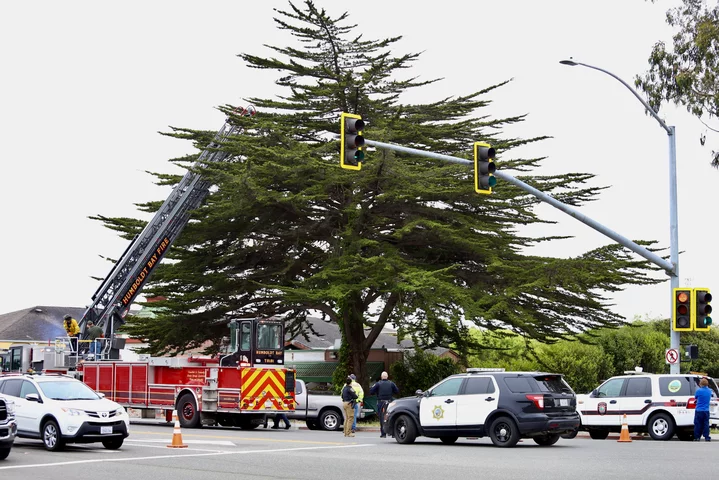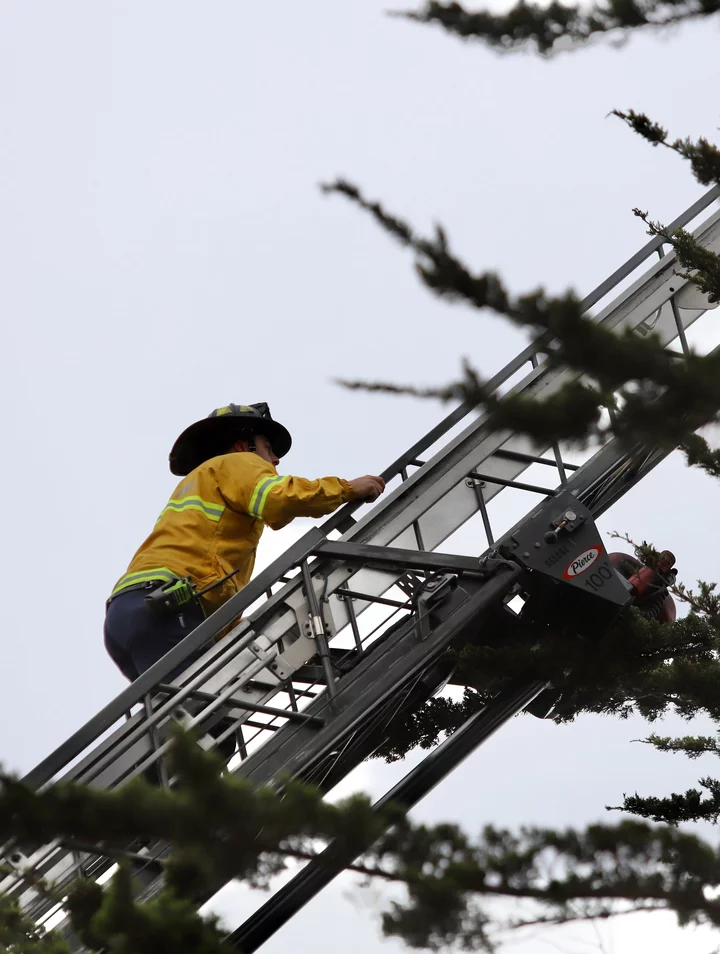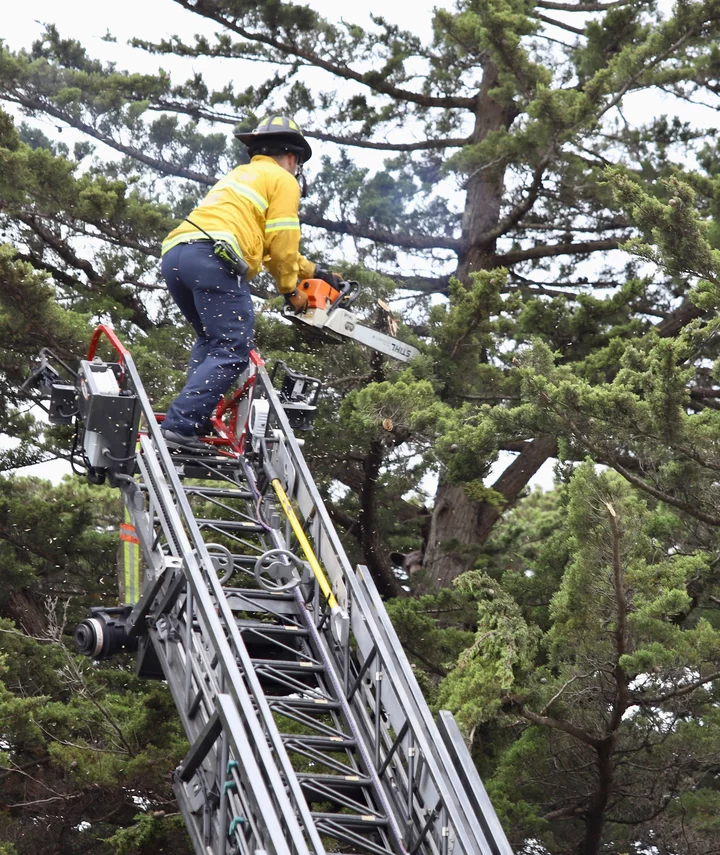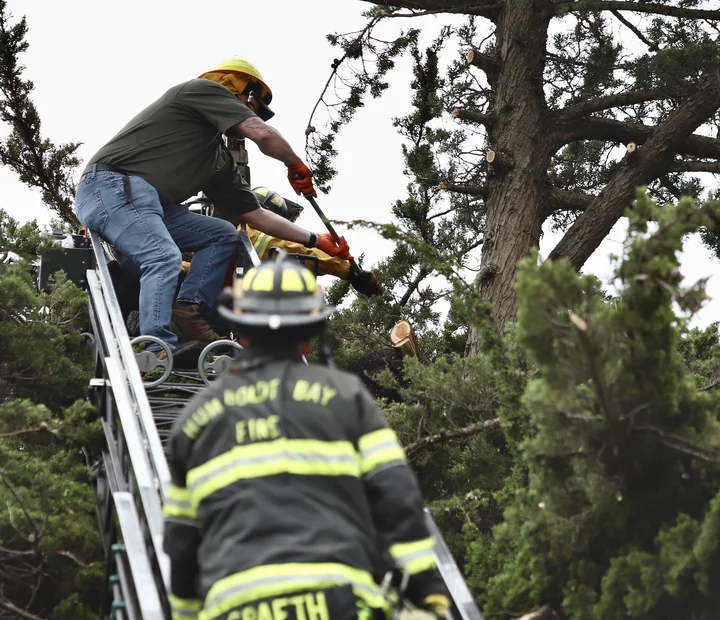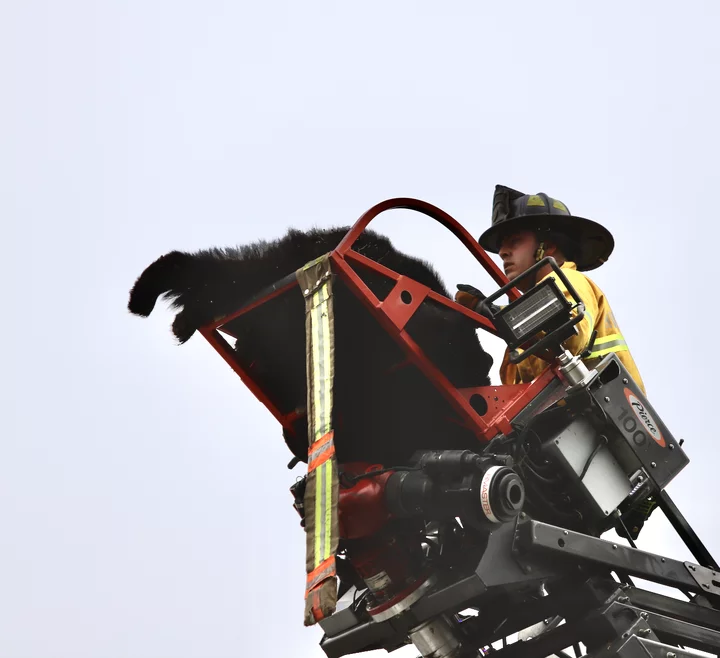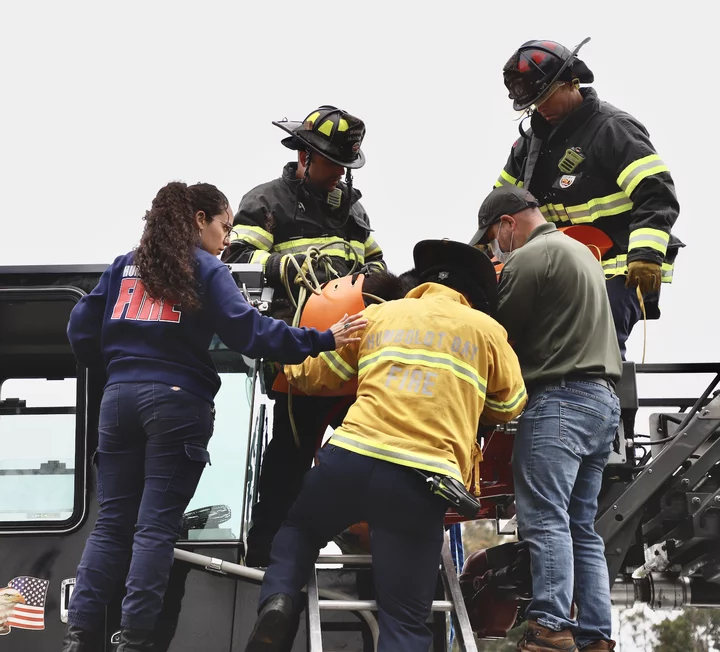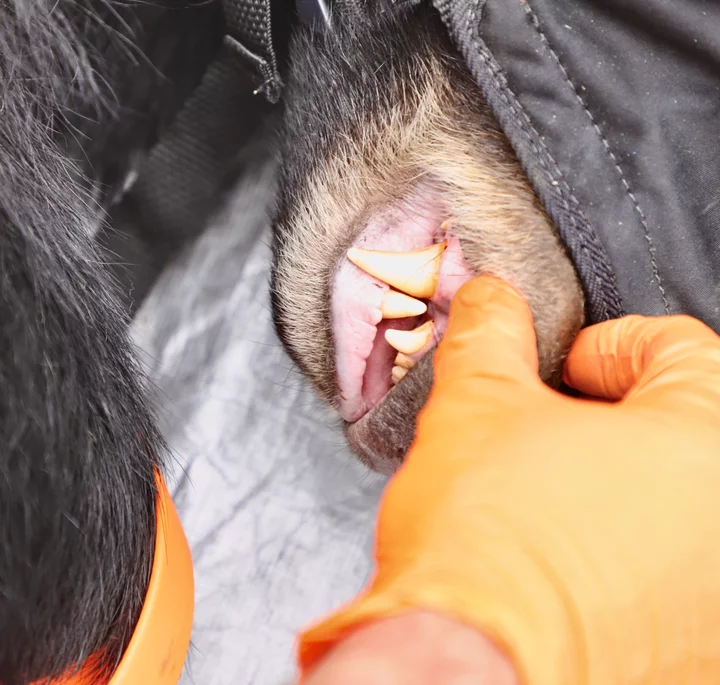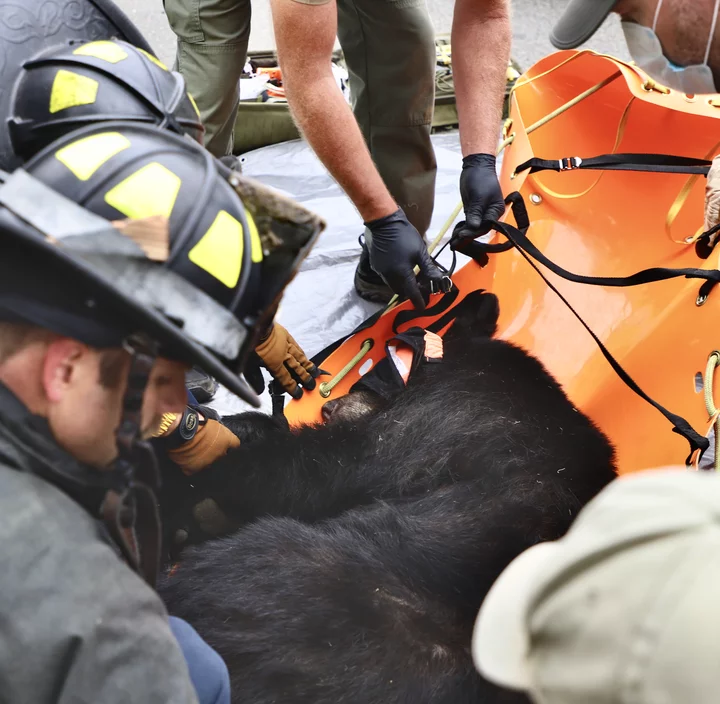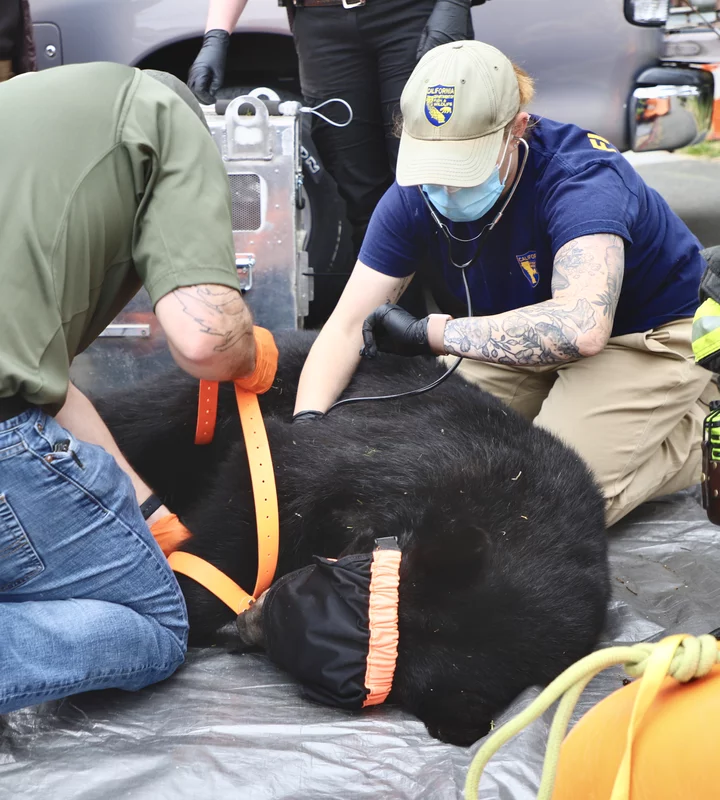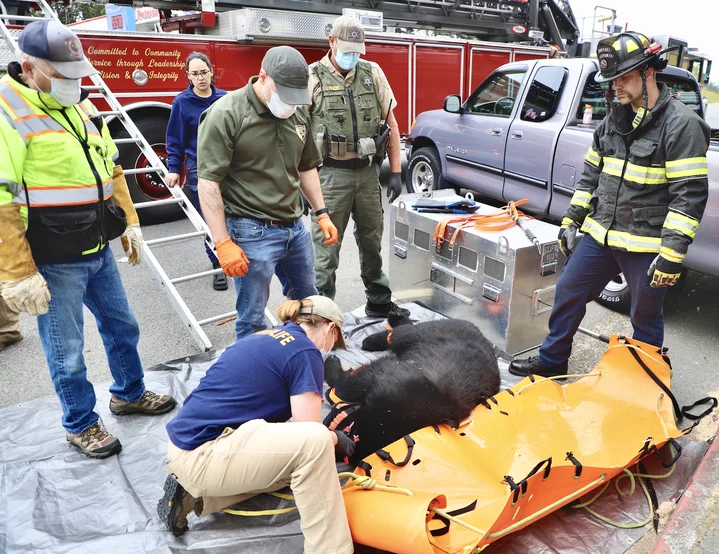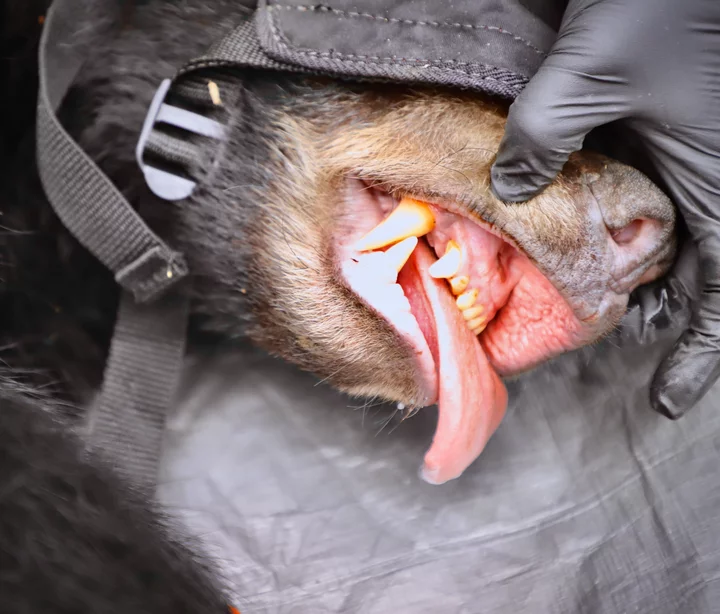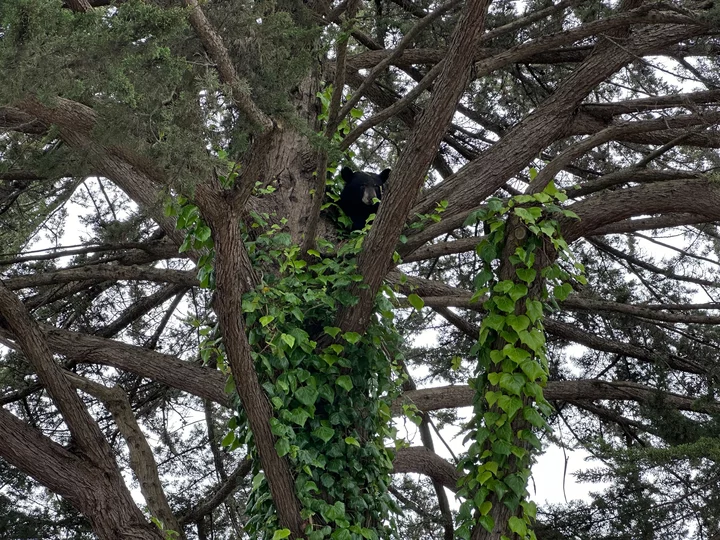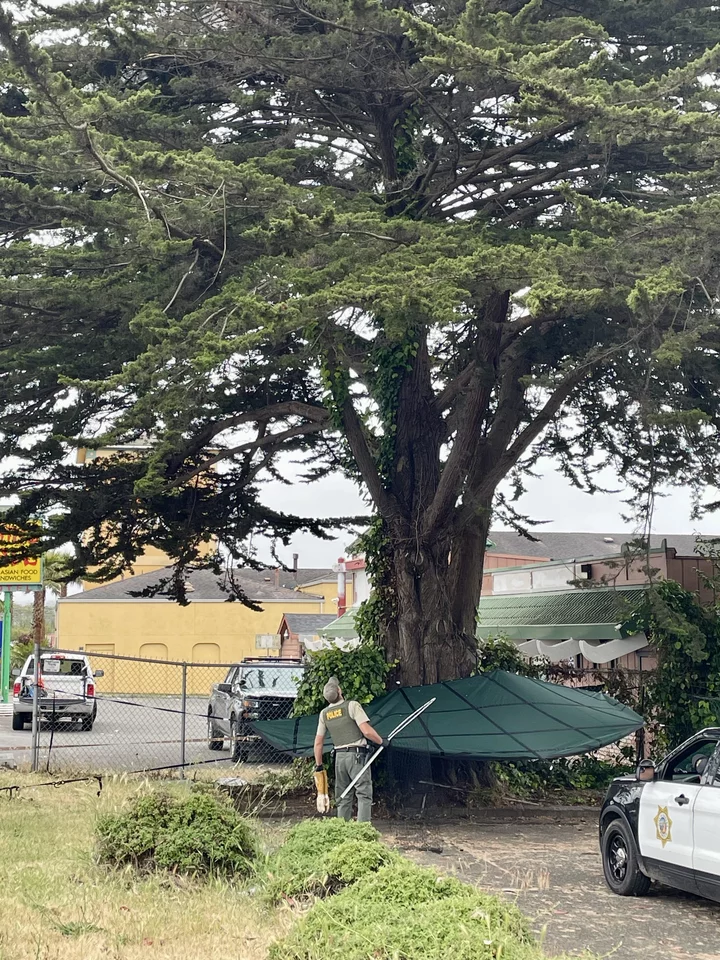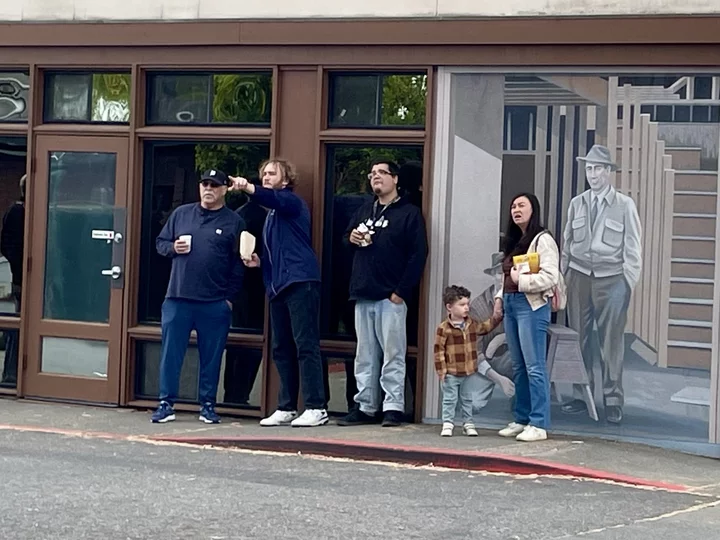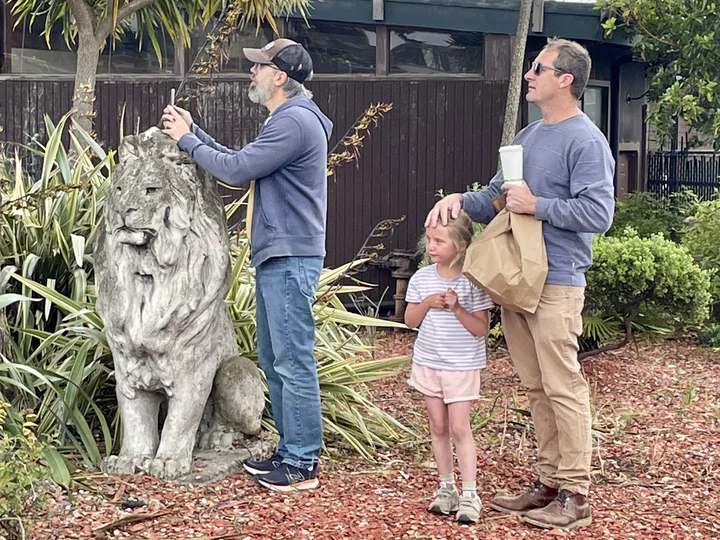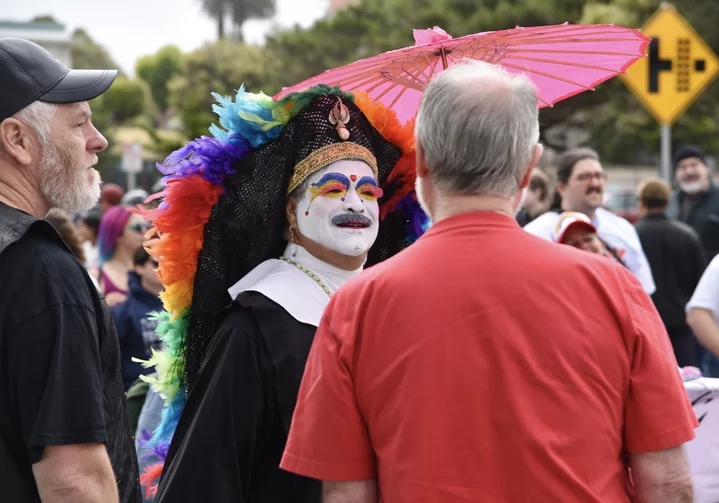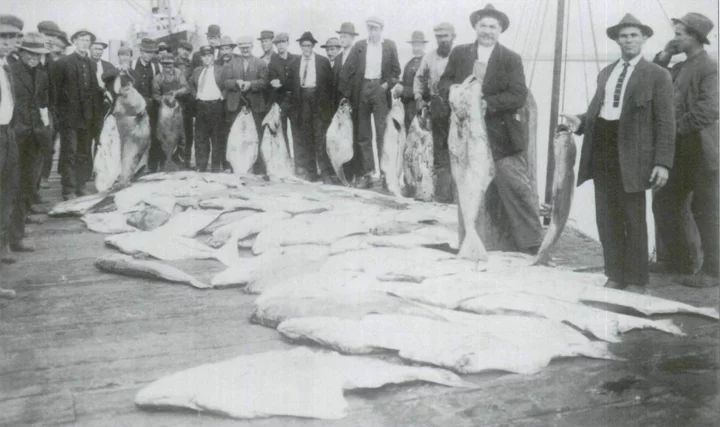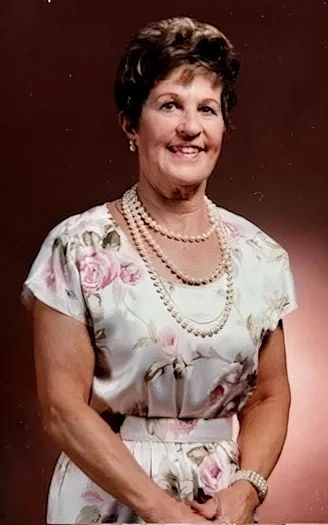(VIDEO) There are Bears in the Tree By Pierson’s
Hank Sims / Monday, June 10, 2024 @ 9:42 a.m. / Animals
Photos: Andrew Goff
UPDATE: 11 a.m.: The mama bear has been removed. Police and firefighters have left the scene. They’re looking for permission to relocate the bears to a state park. More photos of her removal below.
###
UPDATE, 10:30 a.m.: The EPD’s Montaga now tells us that they believe only one cub was up in the tree with the mother bear.
That cub has been removed, as documented in the video below. They’re trying to get the mother out now.
###
UPDATE, 10:05 a.m.: The EPD’s Laura Montagna has some of the backstory.
She says that the bears — again, a mother bear and two cubs — were crossing Broadway from west to east when one of the knucklehead cubs turned around in the middle of the highway, scrambled back to Pierson’s and climbed the tree. The others then followed.
The cubs are now laying down on top of the tranquilized mother bear, up there in the tree. Rescuers are trying to grab the cubs. The Outpost’s Ryan Burns reports that a “sad, crying sound” can be heard coming from the tree, but that it’s unclear whether it is coming from the mother or the cubs.
###
UPDATE, 9:55 a.m. A ladder truck has been deployed. They’re chainsawing branches to try to get better access.
###
ORIGINAL POST:
See that big kerfuffle on the highway in front of Pierson’s?
The reason for that is this: A family of bears have taken up residence in the big tree there. Click the video above to witness them.
Eureka Police Department spokesperson Laura Montagna tells the Outpost‘s Andrew Goff, on scene, that it appears to be a mama bear and two cubs.
As of this writing, the mama bear has been tranquilized, but is still in the tree. Could be a difficult extrication.
Avoid Broadway if possible. We will update.
BOOKED
Today: 6 felonies, 14 misdemeanors, 0 infractions
JUDGED
Humboldt County Superior Court Calendar: Today
CHP REPORTS
1065 Mm199 S Dn 10.70 (HM office): Traffic Hazard
ELSEWHERE
KINS’s Talk Shop: Talkshop December 4th, 2025 – William Honsal
Washington Post: Oregon tribe harvests its first whale in generations
NPR: After federal funding cuts, tribal radio station says silence is not an option
NPR: Family of Colombian man killed in U.S. strike files human rights challenge
Student Loan Relief Deadline Approaching for 300,000 California Borrowers
Mikhail Zinshteyn / Monday, June 10, 2024 @ 7 a.m. / Sacramento
Students walk along the bridge leading into campus on Scholars Lane at the University of California Merced campus on Nov. 4, 2022. Photo by Larry Valenzuela, CalMatters/CatchLight Local
As many as 300,000 Californians have until June 30 to take advantage of a one-time offer to qualify for faster student loan forgiveness, lower monthly payments or outright forgiveness for federal loans borrowed before 2010.The U.S. Department of Education’s June 30 deadline is a big deal because borrowers who submit their applications would become eligible to receive credit for past years of repayment that previously didn’t qualify for student loan forgiveness.The department’s one-time “adjustment” will largely help borrowers who took out federal student loans before 2010 called Federal Family Education Loans — as well as borrowers with two other types of loans.Why is the department doing this? To “remedy years of administrative failures that effectively denied the promise of loan forgiveness to certain borrowers,” said Education Secretary Miguel Cardona in a 2022 press release. The deadline for this remedy has been extended several times, but student loan advocates believe June 30 will be the final opportunity for this one-time benefit.
Nationally, about half of borrowers 60 and older have been repaying their student loans for more than 15 years, a key reason why debt among this population has skyrocketed.By May, more than 1 million Americans have already gotten $51 billion in debt relief through this adjustment program, according to the department.The student loan landscape is notoriously complicated. A National Public Radio reporter whose investigation exposed how borrowers placed in the wrong repayment category lost the ability to gain credit toward loan forgiveness, quipped that if none of this makes sense, “You’re not alone.”
To meet the June 30 deadline, borrowers must submit applications to consolidate their loans into so-called direct consolidation loans. Only loans in the direct program are eligible for loan forgiveness after 10 or 20 years of payments, depending on a borrower’s employment situation. Direct loans also qualify for lower monthly payments.Some borrowers may see no reason to consolidate, but for many others, meeting the June 30 deadline will be a life-changer.
To apply, a borrower needs to create an account with the Federal Student Aid office and then complete the consolidation application, which itself takes about 30 minutes.
California state agency tries to help
Most Californians with loans that aren’t in the direct program should apply to consolidate, said Celina Damian, the state’s first Student Loan Servicing Ombudsperson.
This week California is also debuting a network of 14 nonprofit organizations that collectively received $7 million in state grants to help California borrowers navigate the maze of student loan policies, hurdles and deadlines.The Student Loan Empowerment Network will offer California borrowers in-person or phone consultations to handle their student loan quandaries, including issues surrounding private student loans that are governed by a different set of rules.“It was created really to just have somewhere for borrowers to go and provide more help than I can provide,” Damian said. Until last week, she was the only person in state government doing this work.Between March 20 and May 1, Damian communicated by phone or email with 1,400 borrowers after her office sent an email to Californians who’d likely benefit from loan consolidation.Some borrowers didn’t realize they possessed federal loans that were eligible for any loan forgiveness, Damian said. The borrowers instead thought they were repaying private loans. Others thought her agency’s outreach was initially a scam. “So they would reach out and say, ‘Is this real? I thought there was no option for me,” she recounted.Damian stressed that a growing number of California borrowers are senior citizens who may struggle to complete the federal online application. “The oldest one I spoke to was about 83, 84”, she said. “These are loans they took out in the ‘90s.”Several times borrowers nearly gave up trying to apply, so she told them to complete the paper version of the application and email her photos of their paperwork. She then collated their photos into a PDF document and submitted the paperwork to the U.S. Department of Education on their behalf.
How did we get here?
Federal Family Education Loans were common loans issued by private lenders but guaranteed by the federal government. In 2010, these loans were discontinued and the federal government began issuing student loans directly.
The old loans qualify for federal loan forgiveness programs with less generous repayment plans and require more years of repayment.These loans are also ineligible for Public Service Loan Forgiveness, a loan program for government and nonprofit workers that forgives federal undergraduate and graduate student loan debt after 10 years of payments. The only way to qualify for that loan forgiveness is by repaying direct loans — which borrowers with Federal Family Education Loans can do if they consolidate by June 30. Once their consolidation goes through, borrowers will need to apply for the Public Service Loan Forgiveness program, but they will have inherited past credit already through the steps they took to consolidate.Borrowers need to only apply for consolidation by the June 30 deadline. The department’s actual review process will take at least 60 days.
Borrowers who are found to have made at least 20 years of payments for undergraduate loans or 25 years for graduate loans will see their loans fully forgiven — a tax-free perk through 2025.
Things to consider for student loan forgiveness
A key benefit of consolidation: Borrowers can choose to be placed on the SAVE repayment plan, which bases monthly payments on current income and offers loan forgiveness for any income level after 20 or 25 years.The SAVE plan also doesn’t charge interest as long borrowers make regular payments.Not all periods of repayment will count toward one’s loan credit under the federal government’s one-time program. Any time spent in default won’t count.
Loans in periods of deferment will count, but only before 2013. If loans were deferred because a borrower re-entered college, such as to complete a bachelor’s or earn a master’s degree, that time won’t count toward the borrower’s credit.If borrowers have older loans and Parent PLUS loans that they took out on behalf of their children, they should weigh their options, Damian said. Parent PLUS loans are eligible for only one type of loan forgiveness plan that’s less generous, and consolidating those loans with other loans will block the borrower from the newer repayment plans.
Consolidation may not be for everyone. Borrowers with high incomes, a low loan balance and a discounted interest rate from their lender may not necessarily benefit from this, said Betsy Mayotte, president and founder of The Institute of Student Loan Advisors, a nonprofit group. “But for just about everybody else, there isn’t going to be a downside.”
###
CalMatters.org is a nonprofit, nonpartisan media venture explaining California policies and politics.
GROWING OLD UNGRACEFULLY: Fact or Fiction-fulness?
Barry Evans / Sunday, June 9, 2024 @ 7 a.m. / Growing Old Ungracefully
When the late Hans Rosling and his co-authors (son and daughter-in-law) published Factfulness: Ten Reasons We’re Wrong about the World — and Why Things are Better than You Think in 2018, it was the book many people were waiting to see. Bill Gates promised to give all university graduates a copy; Kirkus Reviews claimed it was, “An insistently hopeful, fact-based booster shot for a doomsaying, world-weary population;” Nature, not usually given to hyperbole, called it “Magnificent…it throws down a gauntlet to doom-and-gloomers.” Not to be outdone, the supposedly apolitical Nobel Prize Foundation said it would “light up Stockholm every spring…in memory of Hans Rosling.”
Who was this guy who brought comfort to so many, and what did he say that turned otherwise skeptical observers of global trends into optimists? Hans Rosling (1948-2017) was a professor of international health at the Swedish Karolinska Institute, one of Time Magazine’s 2012 “World’s Most Influential People,” and international TED speaker. As a physician, over a 20-year period (before his TED star rose) he studied epidemics in sub-Saharan Africa. It wasn’t so much what he said as what he graphed. His forte was plotting world trends, most of which (and all of which, in his book Factfulness) show the decline of bad stuff and the rise of good stuff. Whether it’s population or crime or poverty or pollution or income gaps or hunger or nuclear weapons, things are getting better. We’ve been fooled by all those pessimistic forecasts, and we should be celebrating, rather than worrying.
Factfulness (“This is a book about the world and how it really is”) starts with a pop quiz. Readers are asked to choose from one of three options: In the last 20 years, the proportion of the world population living in extreme poverty has (a) almost doubled; (b) remained more or less the same; (c) almost halved. The answer is (c) — worldwide, we’re doing much better than 20 years earlier (as of 2018). This should come as a shock, if you’re one of the 95 percent Americans who answered (a) or (b).
So far, so good. Rosling made a good case—in his talks and his book—that, by many measures, things are improving. But (big but) he cherry-picked his data, and in doing so, lost much of his credibility. The most obvious sign of his over-optimism is that there’s not a single graph in the book showing bad things getting worse! No global warming, no sea level rise or acidity curves, nothing about microplastics found in virtually everything these days (including human arteries and sperm), it’s silent on the obesity crisis (the World Obesity Atlas estimated that 51 percent of the global population will be obese by 2035). While pointing to increasing numbers of such “flagship species” as rhinos and tigers, the book fails to mention that we’re in the midst of “the sixth mass extinction:” We’re currently causing species extinction at somewhere between 100 and 1,000 times higher than natural background extinction rates.
Average surface temperature of the world’s oceans since 1880. More recently, according to the National Oceanic and Atmospheric Administration, “…every day for more than a year, the average temperature of most of the ocean’s surface has been the highest ever recorded on that date.” (Oceans absorb about 90 percent of greenhouse gas heat.) (NOAA)
Apart from omitting what doesn’t support his “things are getting better” case, Rosling bends his data when it suits him. For instance, around the time the book was published, the average income in the U.S. was $67/day, while it was $11/day in Mexico. (It’s improved somewhat since.) To minimize the gap, the authors use a logarithmic income scale; in one stroke, what had been a sixfold difference is barely noticeable!
Then there’s population. According to Rosling and his co-authors, using U.N. figures, the global population will stabilize by 2100 at between 10 and 13 billion people, relying on the notion that, with the reduction in poverty, people will have fewer children. More children currently survive infancy and childhood with medical advances. “Now that parents have reason to expect that all their children will survive, a major reason for having big families is gone,” according to Factfulness, and “More survivors lead to fewer people.” Tell that to those living in the “public health miracle” republic of Egypt, which has experienced a phenomenal reduction in child mortality over the last six decades (30 percent in 1960, 2 percent today). Despite this, the Egyptian population is currently exploding, from 70 million in 2000 to 114 million today. Apparently, it’s harder to change religious resistance to contraception than it is to prevent childhood diseases through vaccination and other public health measures.
It’s easy to find fault with Factfulness, and my impression is that the authors believe that, overall, things really are getting better. And, to their credit, every graph and statistic has a reference cited, all their data is backed up. Me, I can still look around, count my blessings, and feel outrageous gratitude for the sheer improbability of simply being alive. But, you know how it goes: If you’re not worried, you’re not paying attention. IMHO, Factfulness is guilty of not paying enough attention to what may actually do us in.
(PHOTOS) Humboldt Kicks Off Pride Month with Old Town Parade
Isabella Vanderheiden / Saturday, June 8, 2024 @ 1:45 p.m. / Community , Event
Photos by Isabella Vanderheiden
###
Humboldt kicked off the Redwood Pride Summer Festival this morning with a vibrant parade through Old Town Eureka. A group of about 150 people, adorned in all the colors of the rainbow, marched along Waterfront Drive from the Adorni Center to Madaket Plaza, waving LGBTQ+ flags, blowing bubbles and cheering.
“It’s been a great month so far,” Laine Cohen, an organizer with Redwood Pride, told the Outpost just before the parade began. “The mood is good today. Everybody’s looking chipper. We’re hoping the fog will burn off and it will be a great festival.”
And would you look at that! Sunny skies in Eureka.
The Redwood Pride Festival will continue throughout the day with festivities at the Jefferson Community Center this afternoon and performances at Synapsis later this evening. A complete list of events can be found here.
Keep scrolling for more photos of the Redwood Pride Parade.
###
Woof!
THE ECONEWS REPORT: Wiyot Tribe and BLM Partner for Stewardship of Headwaters
LoCO Staff / Saturday, June 8, 2024 @ 10 a.m. / Environment
Headwaters. By United States Department of the Interior: Bureau of Land Management. Public domain, via Wikimedia.
The Wiyot Tribe has entered into a special partnership with the Bureau of Land Management (BLM) to help manage Headwaters Forest Reserve, part of the Tribe’s ancestral territory. Headwaters Forest needs some help. The majority of the forest is in rough shape from a history of industrial logging, resulting in poor forest health and impaired watersheds. Together, the Wiyot Tribe and the BLM are working to restore the forest through ecological forestry and watershed restoration. The partnership between the two governments allows the Wiyot Tribe to utilize its traditional ecological knowledge in the furtherance of good land stewardship of its ancestral territory for the benefit of the general public. We at the EcoNews think this is really cool.
Marisa McGrew and Zach Erickson of the Wiyot Tribe join Marissa Vossmer and Zane Ruddy of the BLM to discuss their work to restore Headwaters Forest Reserve.
HUMBOLDT HISTORY: Remember Humboldt Bay’s Once-Mighty Shark and Flounder Fisheries? And: Can You Identify the Weird Fishes That Baffled Early White Settlers?
Alan Lufkin / Saturday, June 8, 2024 @ 7:30 a.m. / History
Offshore party boat fishing for halibut has always been popular. [Photo property of HCHS, donated by F. McClaskey]
Visitors to early Humboldt County seemed compelled to describe lyrically the area’s natural beauty, the friendliness of its people, and the great varieties of wildlife to be found.
Humboldt’s pioneers also appreciated the area’s beauty, but the most compelling problem for them was how to make a living in all that abundance. Many turned to one special aspect of the county’s natural endowment; the fish and other aquatic life that thrived in its streams and ocean. Of these, salmon and “salmon-trout” (steelhead) were the most sought- after but by no means the exclusive focus of this interest-other aquatic species were also important. The main purpose of this article is to explore the way early Humboldters tried to earn a living fishing for three of the county’s “other fish,” as reported in the Humboldt Times newspaper (in its various forms and titles) and other published material. Concluding paragraphs will tell about the “funny fish” that tickled reporters’ fancies.
Whales
Whales produced considerable income for Humboldt fishermen for a few decades. As early as September, 1854, the Times reported “immense shoals” of whales found offshore and suggested that with proper equipment local entrepreneurs might do very well in the whaling business if they established a processing plant on the bay. A few months later, the newspaper reported that a whaler, the Canton Packet from the Sandwich Islands, had been lying off the Humboldt bar, seeking whales but finding none; soon after she gave up and sailed south, a large pod of whales appeared in the area. At that time. Captain H. H. Buhne was rigging his small steamer, the Mary Anne, to hunt whales when it wasn’t being used on towing jobs. The California Whaling Company, a new enterprise based in Benicia, was also fitting out whalers for use along the Pacific coast.
During the following summer, small boats from Buhne’s Mary Anne harpooned several humpback whales, which were tried out at facilities on Humboldt Point. One of them yielded twenty-eight barrels of oil, and others possibly more. By 1863, crews from the Mary Anne had killed a total of 114 whales. This was not serious whaling; the “shore-whalers” fished by day and spent their nights at home. The pioneer lumberman James Ryan tumed to whaling part-time when his main business slumped.
During this period. New England whalers—the big boys in the business—resumed operations in California (they had shunned it during the Gold Rush because crewmen often jumped ship to work in the gold fields), and whaling communities were springing up all along the California coast, from Crescent City to Mexico. Whaling ships crowded every inviting cove and estuary until coal and petroleum products killed the demand for whale oil in the marketplace. But by then, California’s whale populations had already been seriously depleted; only a few whales were left by 1875.
Humboldt’s shore-whaling industry of the 1800s was shortlived. Except for an 1861 report that the Crescent City Whaling Company had moved its operation to Trinidad (where it did poorly), the whaling industry faded from the news. In subsequent years, dead whales that washed ashore merited passing notice, but the saga of the early Humboldt whaling industry seems to have been wrapped up with this whimsical item in the January 23, 1875, issue of the Times: “The theory has been started that since the usefulness of whales has largely diminished through the discovery of mineral oils for illuminating purposes, the animal might be domesticated and employed for towing ships.”
Sharks
Shark fishing in Humboldt Bay presents a similar picture of overfishing and loss of market. From 1855 into the 1860s, shovel-nosed sharks were fished extensively for the oil found in their liver, but then they too dropped from the news, except for scary reports of fishermen who suddenly met sharks unexpectedly, and brief items about large dead ones that washed ashore.
Sharks, like the whales, were found in immense numbers; one early report tells how men working on a floating pile driver clubbed thirteen in a half-hour period, which yielded twenty-six gallons of “clear, beautiful oil.” In 1857 some fifteen or twenty small, flat-bottomed boats hunted sharks on the mudflats. Each craft held two men, one to handle the boat, the other the harpoon. The technique was simple; during ebb tides the sharks moved leisurely from one channel to another, exposing their fins as they crossed shallow water. They paid no attention to fishermen pursuing them until the harpoon struck; then they went wild, thrashing about, charging the boat, snapping furiously at anything in their way.
Other Humboldt Bay shark fishermen used hooks and line in deeper channels at high tide, chumming and baiting their hooks with seal meat, which attracted sharks from great distances; the fish would follow the scent near the surface, then dive for the bait on the bottom.
Shark fishing was dangerous work, and more than one report told of men’s hands and arms being mangled. In 1877, well past the heyday of Humboldt’s shark industry, a flounder fisherman drawing in bis line suddenly was confronted by a shark with huge jaws and a terrifying double row of teeth. The shark grabbed his bait, and although the intrepid fisherman managed to grab the beast by the tail and dispatch it with a club, he walked around for some time afterward with one arm in a sling.
These sharks were not small; typical length ranged from four to nine feet. Among six displayed in early May, 1858, near the railroad depot, two were 10 feet long and weighed 300 pounds apiece. Offshore sharks were even larger: a twenty-one-foot bone shark weighing an estimated 3,000 pounds was taken in Crescent City harbor in 1855; in 1873, a thirty-seven-footer-eight feet thick-presumed to have succumbed after “an unpleasantness with his natural enemy, the whale,” washed ashore near the Humboldt lighthouse.
Flounders
Although not as exciting as whales and sharks, flounders were a notable Humboldt export during the latter half of the 1870s through the 1880s. The fish first made news in 1874, when several hundred of them-weighing up to ten pounds apiece-were shipped to the San Francisco market, where they sold for thirty to thirty-five cents a pound. Soon, many hookand-line fishermen began fishing incoming tides, enticing the flat, cross-eyed fish off the bottom by the thousands. By 1876 the Times reported that flounder fishing was becoming “quite an industry here.” More than 100 men were fishing commercially; in February, 1876, the steamers Pelican and Humboldt shipped out eight tons, and similar shipments were reported in subsequent years. In the 1876-77 season (November-Febmary) the amount of fish shipped increased two-thirds over the previous year, but with the vagaries of the market, the income from these shipments increased by only 40 percent.
Although great quantities of founders remained in the bay, and many were still shipped as late as 1887, the Humboldt fishermen lost out to San Francisco Bay Area fishermen in the market, as suggested by this Times item of January 1888: “The fish that went to San Francisco last steamer brought eight cents per pound for salmon, and two and one-half cents per pound for flounder, and during the bad weather last month, when the fishing boats could not fish in San Francisco Bay, or go outside the bay, flounders brought eight cents per pound.”
Ultimately, Humboldt flounders overwhelmed the market. The profit margin-which during the 1870s had been twelve or more cents per pound-dropped to the point where little money was to be made in the flounder industry.
And Funny Fish…
Among the various species of fish commonly found in Humboldt County, unusual specimens resembling ones found in other parts of the country occasionally showed up in fishermen’s catches. When newsmen reported the strange fish, they often included the adjective genuine before the name, imparting a sense of awe that such fish were actually found in Humboldt waters. Thus, terms such as “genuine speckled trout,” “genuine downeast cod,” and “genuine black bass” commonly appeared in fishing reports. Other catches of unfamiliar fish-sometimes fish that local experts could not identify were described in painstaking detail.
Here are several such reports, gleaned from the Humboldt Times by Duane Wainwright:
December 19, 1874. Devil Fish. “One of that somewhat rare, at least in these waters, and ungainly looking aquatic animals was captured on the bay shore near Pearson’s Foundry yesterday. The arms, feet or whatever else they may be called, measured some eight feet from tip to tip. An accurate and intelligible description of this curious specimen is beyond our power….”
December 7, 1878. Sun Fish. “Mr. W. Morrill, of thiscity, has a genuine sunfish, which was cast ashore on the beach and captured a short time since. It fills the description given of that fish to a nicety, being nearly circular in form, shining surface and soft finned-two very small in a line with, and about four or five inches back of the eyes; and two long and narrow near the tail-one above and the other below….”
December 27, 1879. A Queer Fish. “Somebody reports…the finding of a queer fish in the Klamath River which is called the ‘candle fish.’ It is only about eight inches long when grown, is impregnated with oil throughout, and when thoroughly dried can be lighted at either end and will burn like a candle and give an excellent light. It also makes palatable food.”
July 11, 1885. Unknown. “At the fish market on H Street, yesterday afternoon, there was a fish that none of the fishermen could name. Even Geo. Heney, who is familiar with every ‘monster of the deep,’ from shrimp to sperm whale, gave it up. The fish resembles in shape a shark, and is about one foot in length. It is of a dark color with small white spots. The head resembles an animal’s more than that of a fish, and has a set of teeth like a weasel. It has been preserved in alcohol.”
April 17, 1890. A New Edible Fish. “The USS Albatross, while making soundings from Point Reyes to Point Arena, found a new fish, unknown to the markets, in deep sea soundings from 100 to 400 fathoms. It has been named “deep sea sole,” and it belongs to the family of flounders. It has been pronounced a very delicate, fine-flavored fish.”
A Rare Fish “Ed Nichols, of Arcata, sent to the Times yesterday a fish that struck our local anglers dumb with amazement. It is about four feet long, the head being nearly round and armed with a mouth full of long fang-like teeth. The body is long and tapering. Altogether the thing is a regular piscatorial nightmare….”
And from the Femdale Enterprise on November 26, 1891: A Curious Fish. “Mr. Fred Kendall, of the Eel River cannery, sent us the other day a very curious looking fish, evidently a stranger in Eel River waters. It is about eighteen inches in thickness. It has a big hump on its back, five under fins and a partial hawk-bill.”
###
The story above was originally printed in the Summer 1996 issue of the Humboldt Historian, a journal of the Humboldt County Historical Society. It is reprinted here with permission. The Humboldt County Historical Society is a nonprofit organization devoted to archiving, preserving and sharing Humboldt County’s rich history. You can become a member and receive a year’s worth of new issues of The Humboldt Historian at this link.
OBITUARY: A. Elaine Gosselin, 1928-2024
LoCO Staff / Saturday, June 8, 2024 @ 6:56 a.m. / Obits
A.
Elaine Gosselin
Sept. 22,1928 – June 5, 2024
Elaine Gosselin was born September 22, 1928 and raised in Eureka, where she attended Lincoln Elementary School through Eureka High, graduating from EHS in 1946. Elaine spent most summers growing up, helping her Aunt Irma cook for ranch hands at the Sunny Basin Ranch in Bridgeville. This was during WWII, and Elaine learned a lot from her aunt in addition to cooking & baking – like how to make meals stretch, the value of a dollar, as well as vegetable gardening.
After graduating Eureka High, Elaine worked in the office for Brizard-Matthews Machinery Company. In 1948, Elaine married Tony Gosselin and together they built a life, which included lots of hard work. Tony spent long hours at the tire business, Tony Gosselin & Sons’, and Elaine ran an in-home daycare while raising their own three girls and three boys. Later, they would discover a love for RV’ing and spent their retirement years on the road, traversing the entire U.S., being gone months at a time.
Elaine started several family traditions that will live on: the annual siblings camping trip every summer; the “birthday lunches” with the girls; the Gosselin Family Christmas reunion; and, waving good-bye each and every time one of her visitors left (initially, on her front porch and later, from the living room window). This wave good-bye over the years has been nicknamed “The Elaine Wave.”
Her love of nature, visiting and laughing over a good card game, and her devotion to her family were uniquely embedded in her wonderfully energetic and lively spirit. Indeed, she had many special traits, including letter writing. She was so thoughtful and always thanked you either with a phone call or note, or both. She was the beloved matriarch of the Gosselin family and will be deeply missed.
Elaine’s parents, Norton and Blanche Johnson; her sister, Mildred Harper; brother Arthur E. Johnson; grandson, Bryan Hubbard; husband, A. J. ‘Tony’ Gosselin, Jr; and, son-in-law, Peter Presnell, preceded her in death.
Elaine is survived by her six children, Ann Gosselin, Steve (Betsy) Gosselin, Paul (Melanie) Gosselin, Marie (Dave) Eberhardt, Terrie (Dan) Cruz, and Joe (Sherrie) Gosselin; and, grandchildren, Chad (Kari) Gosselin, Angie (Paul) Ubaldi, Chris (Suji) Shobert; Sara (Casey) Cassidy, Amy (Huna) Borden, Matt Eberhardt, Marc (Sara) Eberhardt, Sara Farley, Jacob Eberhardt, Shane Gosselin, Shannon (Ted) Alves, Travis (Shanae) Gosselin, Crystal (Jeff) Mayberry, Will (Brianne) Morgan, Kenny Cruz, Katie (Shawn) Maples, Cody (Nikki) Cruz, Jenae (Doug) Alves, and TJ Gosselin; as well as thirty great-grandchildren; three great-great-grandchildren and numerous other family members and friends who lovingly called her by her nickname, “Grandma Goose.”
The Gosselin family is deeply grateful for the years of attentive, loving care Elaine received from her caretakers, Reina and Mike Earhart, who made the last years of Elaine’s life as comfortable as they possibly could be.
To honor Elaine’s wishes, there will be no services.
###
The obituary above was submitted on behalf of Elaine Gosselin’s loved ones. The Lost Coast Outpost runs obituaries of Humboldt County residents at no charge. See guidelines here.

